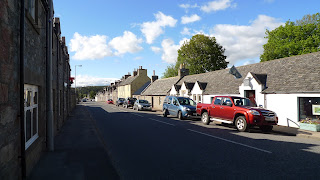Much of England is built of softer, less durable materials, because back in the days when one was ordinarily obliged to use only local materials, sand and clay and straw were pressed into service for vernacular building. And so much of old England was, if not wattle-and-daub on a timber frame, then brick. And generally not hard rock. Of course, there were exceptions in the West Country, and in Northern hill country, where stone was available in abundance; and really important buildings - castles, cathedrals, churches, palaces, mansions, town halls - were always built of stone, throughout the land, if funds permitted. But in Wales, and especially in Scotland, stone was the rule, even where brick would have done.
So in Scotland every village and small town that has not expanded too much since 1945 continues to show a grey face compared to similar villages and towns in most of England. This is sometimes offset by bright (if not lurid) exterior wall-painting, or (in summer) a profusion of hanging baskets. But many a Scottish town looks rather plain, if not actually grim. I'll show you some prime examples seen in my recent travels.
First, Macduff, on the northern coast of Aberdeenshire. Macduff is across the bay from Banff. They are practically twin towns. Banff is the ancient centre; Macduff is the working fishing town. Here is the harbour, which is spruce enough.
And where were the signs of decades of oil wealth - did it always pass these towns by? Could the decline of sea fishing in recent decades be the main reason for the apparent half-death of all these places?
I quite liked Banff - even though it too lacked a modern shopping centre - partly because the sun came out and lit up its best bits to advantage. Banff wears an air of importance. It has more history to show than Macduff, with several nice town houses, a market square, an ancient churchyard full of unusual tombs, and an attractive steep alleyway, connecting the upper and lower levels.
And this was the Order of Service, and the grave:
Another stone-built coastal place in Aberdeenshire. This time, just a village - a little place called Sandend. I liked it very much. It was small and peaceful, the only place I found on this part of the coast that I would personally describe as 'pretty'. The sea water was wonderfully clear, and the rocks were interesting and photogenic.
Here is the Town Hall, and the less-than-inviting Youth Café at its rear. I wonder if it ever opens?
This is the furniture store, accommodated in what once might have been the town cinema, though I'm not sure.
Burghead did have a nice harbour:
I got the impression that it reckoned itself to be something of a holiday destination. A North-Eastern Scotland version of Padstow. Well, possibly...
Finally, two inland towns, to show that away from the coast the towns can be more welcoming in their general appearance, even if stone-built. Here's Forres:
This is where I chatted to Sally and Karen...
...and tried on silly hats at the Falconer Museum:
And finally Tomintoul, claimed to be the Highest Village in the Grampians. Given its situation high in the mountains, I was expecting it to have a last-outpost-of-civilisation atmosphere, but no: there was a sunny main street, and, wonder of wonders, a big lawned square with nice trees! To be sure, Tomintoul was the local focus for winter sports, and the Lecht Ski Centre was just up the road. So it had acquired modern reasons to exist, and several of the shops were the sort that catered for the sporty tourist. But I still found the lawned square charming.
It all looks crisp and almost military in the mountain sunshine, doesn't it? But stone can do crisp very well. I respect these stone-built towns, and want to see much more of them in further travels; but I do prefer the softer, mellow, colourful, flower-planted garden walls and thatched cottages of Southern England. Such as those in these scenes from Amberley in West Sussex:
And I never saw a hedge like this one, near Portelet Harbour on Guernsey, when walking around Macduff, Banff, Lossiemouth, Burghead, or even Sandend, even though it was June:






















































